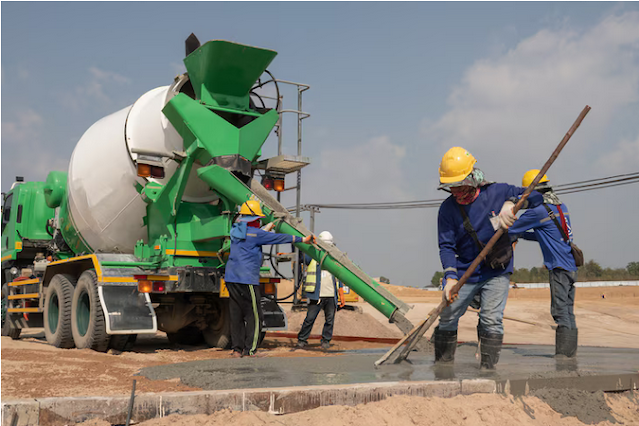Here are a few things you should know before ordering ready mixed concrete
Ready-mix concrete refers to concrete that has been mixed in the stationary mix in the central batching/mixing plant. It is delivered to the customer in a fresh condition. It is delivered in a truck. The mixture is then mounted on the self-propelled chassis that can mix the concrete ingredients during transportation. In other words, ready-mix concrete is transported on a specially-designed truck known as a transit mixer. The concrete is rotated continuously until it is ready for use. i.e. placed. Ready-mix concrete is an excellent alternative to the ordinary concrete mix. It requires less time and effort, as well as being cheaper. Ready-mix concrete is a unique material because it maintains uniform quality throughout the construction process and allows for high-speed concrete construction. Ready-mixed concrete eliminates problems such as poor workability, bleeding, water-cement ratio, and insufficient mixing time that is often encountered with traditional concrete mixes.
01. Grade of concrete or mix design
· Concrete types you can do include: foundation slab, floor slab, pavements, etc.
· You can specify the grade of concrete that you need on-site. M15, M20, M25, M30, etc
· Concrete slump at both the batching plant as well as at the site
· Concrete volume in cubic meters or cubic yards
· Concrete pouring address
· Ready-mix concrete is required on-site within a reasonable time.
· The time between RMC's two consecutive deliveries (in the event of a larger quantity, i.e. Greater than 6 cubic meters
02. Fly Ash Excessive Use: Be aware
It is important to determine the amount of fly ash that has been added to concrete. RMC producers may add a high level of fly ash to concrete, which is not recommended by the standards. Fly ash is usually added to the concrete at levels of 15% to 25% of the cementations component. This is done to lower costs and increase profits for the plant owners. Buyers should be aware of RMC prices before purchasing it. Ask your dealer for this information before ordering ready-mix concrete. I.e. Details of mixed design
03. Source of ingredients
Concrete ingredients are purchased from different sources by RMC dealers. There are good and bad sources. It is important to assess the source of each dealer. You can select the ready-mix dealer if their suppliers are well-known in the local market for quality.
04. Transport time
It is recommended that ready-mix concrete supplier London be poured within two hours of the time of loading at central batching plants. If retarding admixture was used, however, it may be possible to pour the concrete for a longer time. However, it is important to determine which retarder was used and follow all instructions as directed by the retarding manufacturer.
05. Mixture
To improve concrete's workability, it is possible to add admixture at the site. Admixtures can contain chlorides. In these cases, it is important to determine the percentage of total chloride in the admixture. Ready-mix concrete with high levels of chloride can cause corrosion and decrease the building's service life. These admixtures should not be used. Nowadays, no one uses chloride-based admixtures.
06. Test of Concrete
Standard requirements stipulate that ready-mix concrete dealers must have facilities to conduct routine tests at their premises. Concrete slump test and concrete cube testing are some examples. This allows you to cross-check the strength and workability of the concrete ordered. A slump test can be done on-site to check concrete's workability. Concrete's slump is largely dependent on its condition and the level of workability required. IS 456:2000 defines low reinforced sections as slabs, beams, and walls. Cast with a slump between 25 and 75 mm. Sections that are heavily reinforced, such as slabs, beams and walls, columns, walls, and so on, will be able to withstand high loads. Cast with a slump between 50 and 100 mm. Slip formwork and pumped concrete require a slump of 75 to 100 mm.
07. Traffic Problem
Some city police have created new rules to help reduce congestion on the roads and prevent traffic accidents. They restrict the movement of goods and heavy vehicles during peak hours to clear the roads. If you live in such a city, it is important to plan concrete pouring according to these traffic rules.
08. Information regarding Delivery Ticket for Ready Mix Concrete
This information should be included on each batch's ready-mix concrete delivery ticket:
· Name and number for the ready-mixed concrete plants
· Date and serial number
· Number
· Name and address of the buyer
· Concrete grade
· Mix design details
· Table format
· Type and size of concrete materials
· Concrete volume per cubic meter
· Time is taken to load
· Batching plant results in a slump
· The signing of the concrete plant operator
On-site, you will need to fill out the following information: Ready Mix Concrete Tickets
· Arrival time
· When the discharge was complete
· Any water/admixture that is added to the site
· Concrete pouring location
· Slump test results at the site
· Signature of RMC receiver
Concrete is becoming more popular every day, but it also has a high environmental cost. Natural materials are being mined and processed daily. This can leave a negative impact on the environment. It was possible to increase the value of ready-mix concrete by exploring the properties of waste materials and byproducts such as fly ash. This shows that we now recognize the effects of unhealthy environments and are moving towards green materials, which help to create green buildings.




Comments
Post a Comment